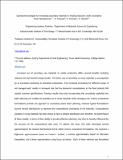| dc.contributor.author | Gaustad, Gabrielle | |
| dc.contributor.author | Noshadravan, Arash | |
| dc.contributor.author | Olivetti, Elsa A. | |
| dc.contributor.author | Kirchain Jr, Randolph E | |
| dc.date.accessioned | 2017-06-15T15:00:28Z | |
| dc.date.available | 2017-09-03T05:00:05Z | |
| dc.date.issued | 2016-11 | |
| dc.identifier.issn | 2199-3823 | |
| dc.identifier.issn | 2199-3831 | |
| dc.identifier.uri | http://hdl.handle.net/1721.1/109890 | |
| dc.description.abstract | Increased use of secondary raw materials in metal production offers several benefits including reduced cost and lowered energy burden. The lower cost of secondary or scrap materials is accompanied by an increased uncertainty in elemental composition. This increased uncertainty for different scraps, if not managed well, results in an increased risk that the elemental concentrations in the final products fall outside customer specifications. Previous results show that incorporating this uncertainty explicitly into batch planning can modify the potential use of scrap materials while managing risk. Chance-constrained formulations provide one approach to uncertainty-aware batch planning; however, typical formulations assume normal distributions to represent the compositional uncertainty of the materials. Compositional variation in scrap materials has been shown to have a skewed distribution, and therefore, the performance of these models, in terms of their ability to provide effective planning, it may then be heavily influenced by the structure of the compositional data used. To address this issue, this work developed several approximations for skewed distributional forms within chance-constrained formulations. We explored a lognormal approximation based on Fenton’s method; a convex approximation based on Bernstein inequalities; and a linear approximation using fuzzy set theory. Each of these methods was formulated and case studies executed using compositional data from an aluminum remelter. Results indicate that the relationship between the underlying structure/distribution of the compositional data and how these distributions are formulated in batch planning can modify the use of secondary raw materials. | en_US |
| dc.description.sponsorship | National Science Foundation (U.S.) (Award 1133422) | en_US |
| dc.publisher | Springer International Publishing | en_US |
| dc.relation.isversionof | http://dx.doi.org/10.1007/s40831-016-0100-6 | en_US |
| dc.rights | Creative Commons Attribution-Noncommercial-Share Alike | en_US |
| dc.rights.uri | http://creativecommons.org/licenses/by-nc-sa/4.0/ | en_US |
| dc.source | Springer International Publishing | en_US |
| dc.title | Operational Strategies for Increasing Secondary Materials in Metals Production Under Uncertainty | en_US |
| dc.type | Article | en_US |
| dc.identifier.citation | Noshadravan, Arash et al. “Operational Strategies for Increasing Secondary Materials in Metals Production Under Uncertainty.” Journal of Sustainable Metallurgy 3.2 (2017): 350–361. | en_US |
| dc.contributor.department | MIT Materials Research Laboratory | en_US |
| dc.contributor.department | Massachusetts Institute of Technology. Department of Materials Science and Engineering | en_US |
| dc.contributor.department | Massachusetts Institute of Technology. Engineering Systems Division | en_US |
| dc.contributor.mitauthor | Noshadravan, Arash | |
| dc.contributor.mitauthor | Olivetti, Elsa A. | |
| dc.contributor.mitauthor | Kirchain Jr, Randolph E | |
| dc.relation.journal | Journal of Sustainable Metallurgy | en_US |
| dc.eprint.version | Author's final manuscript | en_US |
| dc.type.uri | http://purl.org/eprint/type/JournalArticle | en_US |
| eprint.status | http://purl.org/eprint/status/PeerReviewed | en_US |
| dc.date.updated | 2017-05-06T05:15:14Z | |
| dc.language.rfc3066 | en | |
| dc.rights.holder | The Minerals, Metals & Materials Society (TMS) | |
| dspace.orderedauthors | Noshadravan, Arash; Gaustad, Gabrielle; Kirchain, Randolph; Olivetti, Elsa | en_US |
| dspace.embargo.terms | N | en |
| dc.identifier.orcid | https://orcid.org/0000-0002-8043-2385 | |
| mit.license | OPEN_ACCESS_POLICY | en_US |
